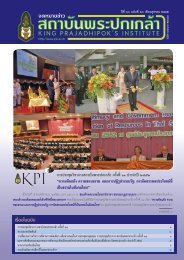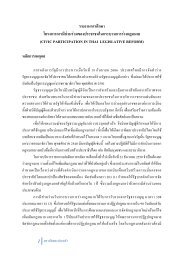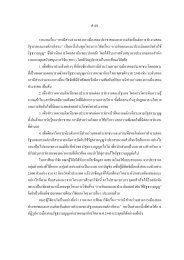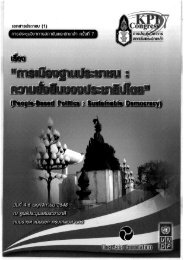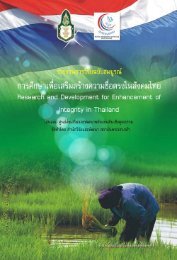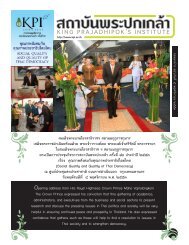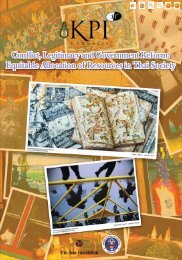SUFFiciENcy EcONOMy ANd GRASSROOtS DEvElOPMENt
SUFFiciENcy EcONOMy ANd GRASSROOtS DEvElOPMENt
SUFFiciENcy EcONOMy ANd GRASSROOtS DEvElOPMENt
Create successful ePaper yourself
Turn your PDF publications into a flip-book with our unique Google optimized e-Paper software.
The Meaning of Sufficiency Economy <br />
International Conference<br />
235<br />
parts of the establishment, had been practising and promoting sufficiency economy<br />
decades before the economic crisis in 1997. 5<br />
The most important element of the Asoke self-sufficiency ideas is to switch to<br />
organic agriculture from the chemical-intensive agriculture. Asoke group has also<br />
been promoting the idea of integrated agriculture, where different plants are mixed<br />
in a mutually beneficial way. Many of these Asoke policies can be traced back to the<br />
ideas of Buddhist Economics as presented by E.F. Schumacher in his path breaking<br />
article “Buddhist Economics” in the book “Small Is Beautiful” from 1973.<br />
<br />
BUDDHIST ASOKE MOVEMENT<br />
The Buddhist Asoke group has been somewhat of a pioneer in Thailand in<br />
practising self-sufficiency in the village community level. The group has been highly<br />
successful in its endeavour and has become a showcase to various Thai<br />
governments, particularly after the disastrous collapse of the “bubble economy” in<br />
1997, and after the famous speech by H.M. the King, in December 1997, supporting<br />
and encouraging the Thai society to become more self-sufficient.<br />
The Asoke is a Buddhist group, established by a Buddhist monk Bodhiraksa , 6<br />
who ordained in the state sangha forty years ago. He was not impressed with the<br />
practice of the mainstream Buddhist monks and ended up forming his own group of<br />
disciples. The group is strictly vegetarian, puts emphasis on the monastic vinaya<br />
rules, ordains women as Ten-Precept nuns (Sikkhamats), and presents sometimes<br />
very radical interpretations of Buddhist Pali concepts, thus annoying the state<br />
Buddhist monastic authorities, the Council of Elders (Mahatherasamakhom) and the<br />
traditionally rather lax and fun-loving Thai monks and lay Buddhists.<br />
Asoke group’s economic visions, however, have been met more positively. The<br />
group was founded in the 1970s, and the first Thai books and articles about the<br />
group, usually classified the Asoke group as “Utopian”. 7 <br />
The group has several well-established Buddhist centres in various parts of<br />
Thailand: Bangkok, Nakhon Pathom, Nakhon Ratchasima, Sisaket, Ubon<br />
Ratchathani, Nakhon Sawan and Chiang Mai. Several new budding centres are<br />
5<br />
The Asoke group is perceived as extremely controversial in Thailand, partly due to the<br />
group’s strict vegetarianism and initial rejection of Buddha images. Recently, the group also joined<br />
the anti-Thaksin ‘yellow shirt’ demonstrations. See Heikkil?-Horn (2010).<br />
6<br />
In Thai he is known as: Samana Phothirak or Pho Than Phothirak.<br />
7<br />
Suwanna Satha-anand (1990) refers to the two articles written earlier in Thai by Sombat<br />
Chantronwong “The Pathom Asoke Community. A Study of Buddhist Utopia.”, and Prawet Wasi<br />
“Suan Mok, Thammakai, Santi Asok” both from 1988. Apinya Fuengfusakul used the same term as<br />
late as in 1993 in her article “Empire of Crystal and Utopian Commune: Two types of contemporary<br />
Theravada reform in Thailand”. Recent scholarship also regards the Asoke group relatively<br />
positively in terms of their live style; see Essen (2005) and Kanoksak (2008).



